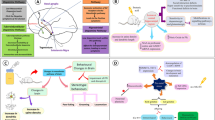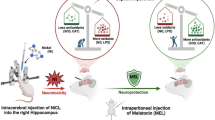Abstract
The present study was to investigate the anticonvulsant and antiepileptogenic potential of thymol. Anticonvulsant activity of thymol (5–100 mg/kg i.p.) was studied using maximal electroshock, pentylenetetrazole (PTZ), strychnine and 4-aminopyridine (4-AP) models. Thymol at the selected dose was also studied for its effect on locomotion. Antiepileptogenic property of thymol (5–25 mg/kg) was evaluated using PTZ-induced kindling model along with its effect on malondialdehyde and glutathione levels. Thymol (50 and 100 mg/kg, i.p.) showed anticonvulsant activity against maximal electroshock and pentylenetetrazole (66.66 and 83.33 % protection at 50 and 100 mg/kg, respectively) model but not against strychnine and 4-aminopyridine models. Thymol exhibited decreased locomotor activity in dose-dependent manner at the same dose range. Thymol at the dose of (25 mg/kg, i.p.) significantly decreased the seizure score, increased glutathione levels and decreased malondialdehyde levels in pentylenetetrazole-induced kindling model. Thymol exhibited significant anticonvulsant and antiepileptogenic property.


Similar content being viewed by others
Abbreviations
- GABAA :
-
Gamma aminobutyric acid
- HLE:
-
Hind limb extension
- ICT:
-
Institute of Chemical Technology
- IAEC:
-
Institutional Animals Ethics Committee
- MES:
-
Maximal electroshock
- MDA:
-
Malondialdehyde
- PTZ:
-
Pentylenetetrazole
- ROS:
-
Reactive oxygen species
- STR:
-
Strychnine
- 4-AP:
-
4-Aminopyridine
References
Atilla I, Ahmet G, Ferah A, Suat K, Mustafa I (2005) Antiepileptogenic and antioxidant effects of Nigella sativa oil against pentylenetetrazole induced kindling in mice. Neuropharmacology 49(4):456–464
Bhutada P, Mundhada Y, Bansod K, Dixit P, Umathe S, Mundhada D (2010) Anticonvulsant activity of berberine, an isoquinoline alkaloid in mice. Epilepsy Behav 18:207–210
Bondy SC (1995) The relation of oxidative stress and hyperexcitation to neuronal disease. Proc Soc Exp Biol Med 208:337–345
Coulter DA, Huguenard JR, Prince DA (1989) Characterization of ethosuximide reduction of low-threshold calcium current in thalamic neurons. Ann Neurol 25:582–593
Ellman GL (1959) Tissue sulfhydryl groups. Arch Biochem Biophys 82:70–77
Garcia DA, Bujons J, Vale C, Sunol C (2006) Allosteric positive interaction of thymol with the GABAA receptor in primary cultures of mouse cortical neurons. Neuropharmacology 50:25–35
Gilani AH, Jabeen Q, Ghayur MN, Janbaz KH, Akhtar MS (2005) Studies on the antihypertensive, antispasmodic, bronchodilator and hepatoprotective activities of the Carum copticum seed extract. J Ethnopharmacol 98:127–135
Haeseler G, Maue D, Grosskreutz J, Bufler J, Nentwig B, Piepenbrock S, Dengler R, Leuwer M (2002) Voltage-dependent block of neuronal and skeletal muscle sodium channels by thymol and menthol. Eur J Anesthesiol 19:571–579
Jain S, Bharal N, Khurana S, Mediratta P, Sharma K (2011) Anticonvulsant and antioxidant of trimetazidine in pentyelenetetrazole induced kindling model in mice. Naunyn-Schmied Arch Pharmacol 383:385–392
Kaur GJ, Arora DS (2009) Antibacterial and phytochemical screening of Anethum graveolens, Foeniculum vulgare and Trachyspermum ammi. BMC Complement Altern Med 9(30):1–10
Loscher W (2002) Animal models of epilepsy for the development of antiepileptogenic and disease-modifying drugs. A comparison of the pharmacology of kindling and post-status epilepticus models of temporal lobe epilepsy. Epilepsy Res 50:105–123
Loscher W, Schmidt D (1988) Which animal models should be used in the search for new antiepileptic drugs? A proposal based on experimental and clinical considerations. Epilepsy Res 2:145–181
Macdonald RL, Kelly KM (1995) Antiepileptic drug mechanisms of action. Epilepsia 36:S2–S12
Mahendran S, Thippeswamy BS, Veerapur VP, Badami S (2011) Anticonvulsant activity of embelin isolated from Embelia ribes. Phytomedicine 18:186–188
McCabe RT, Wasterlain CG, Kucharczyk N, Sofia RD, Vogel JR (1993) Evidence for anticonvulsant and neuroprotectant action of felbamate mediated by strychnine-insensitive glycine receptors. J Pharmacol Exp Ther 264:1248–1252
Mehla J, Reeta KH, Gupta P, Gupta YK (2010) Protective effect of curcumin against seizures and cognitive impairment in a pentylenetetrazole-kindled epileptic rat model. Life Sci 7:596–603
Mohagheghzadeh A, Faridi P, Ghasemi Y (2007) Carum copticum Benth. & Hook., essential oil chemotypes. Food Chem 100:1217–1219
Mohammadi B, Haeseler G, Leuwer M, Dengler R, Krampfl K, Bufler J (2001) Structural requirements of phenol derivatives for direct activation of chloride currents via GABAA receptors. Eur J Pharmacol 421:85–91
Okaha H (1979) Assay for lipid peroxide in animal tissue by thiobarbituric acid reaction. Anal Biochem 95:351–358
Patil MS, Patil CR, Patil SW, Jadhav RB (2011) Anticonvulsant activity of aqueous root extract of Ficus religiosa. J Ethnopharmacol 133:92–95
Priestley CM, Williamson EM, Wafford KA, Sattelle DB (2003) Thymol, a constituent of thyme essential oil, is a positive allosteric modulator of human GABAA receptors and a homo-oligomeric GABA receptor from Drosophila melanogaster. Br J Pharmacol 140:1363–1372
Raza M, Chaudhary MI (2000) Medicinal plants with anticonvulsant activities. Stud Nat Prodt Chem 22(3):507–553
Rezvani ME, Roohbakhsh A, Mosaddegh MH, Esmailidehaj M, Khaloobagheri F, Esmaeili H (2011) Anticonulsant and depressant effects of aqueous extracts of Carum copticum seeds in male rats. Epilepsy Behav 22:220–225
Rogawski MA, Porter RJ (1990) Antiepileptic drugs: pharmacological mechanisms and clinical efficacy with consideration of promising developmental stage compounds. Pharmacol Rev 42:223–286
Shin EJ, Jeong JH, Chung YH, Kim WK, Ko KH, Bach JH, Hong JS, Yoneda Y, Kim HC (2011) Role of oxidative stress in epileptic seizures. Neurochem Int 59:122–137
Sowemimo AA, Adio O, Fageyinbo S (2011) Anticonvulsant activity of the methanolic extract of Justicia extensa T. Anders. J Ethnopharmacol 138:697–699
Thakur VD, Mengi SA (2005) Neuropharmacological profile of Eclipta alba (Linn.) Hassk. J Ethnopharmacol 102:23–31
Uma PK, Geervani P, Eggum BO (1993) Common Indian spices: nutrient composition, consumption and contribution of dietary value. Plant Food Hum Nutr 44:137–148
Yamaguchi S, Rogawski MA (1992) Effects of anticonvulsant drugs on 4-aminopyridine-induced seizures in mice. Epilepsy Res 11:9–16
Yanishlieva NV, Marinova EM, Gordon MH, Raneva VG (1999) Antioxidant activity and mechanism of action of thymol and carvacrol in two lipid systems. Food Chem 64:59–66
Acknowledgement
The authors would like to thank to UGC-SAP for funding the research.
Conflict of interest
The authors have declared that there is no conflict of interest.
Author information
Authors and Affiliations
Corresponding author
Rights and permissions
About this article
Cite this article
Sancheti, J., Shaikh, M.F., Chaudhari, R. et al. Characterization of anticonvulsant and antiepileptogenic potential of thymol in various experimental models. Naunyn-Schmiedeberg's Arch Pharmacol 387, 59–66 (2014). https://doi.org/10.1007/s00210-013-0917-5
Received:
Accepted:
Published:
Issue Date:
DOI: https://doi.org/10.1007/s00210-013-0917-5




